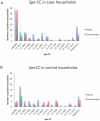The environment as an unrecognized reservoir for community-associated methicillin resistant Staphylococcus aureus USA300: a case-control study
- PMID: 21818321
- PMCID: PMC3144231
- DOI: 10.1371/journal.pone.0022407
The environment as an unrecognized reservoir for community-associated methicillin resistant Staphylococcus aureus USA300: a case-control study
Abstract
Background: Community-associated methicillin-resistant Staphylococcus aureus (CA-MRSA) infections are spreading, but the source of infections in non-epidemic settings remains poorly defined.
Methods: We carried out a community-based, case-control study investigating socio-demographic risk factors and infectious reservoirs associated with MRSA infections. Case patients presented with CA-MRSA infections to a New York hospital. Age-matched controls without infections were randomly selected from the hospital's Dental Clinic patient population. During a home visit, case and control subjects completed a questionnaire, nasal swabs were collected from index respondents and household members and standardized environmental surfaces were swabbed. Genotyping was performed on S. aureus isolates.
Results: We enrolled 95 case and 95 control subjects. Cases more frequently reported diabetes mellitus and a higher number of skin infections among household members. Among case households, 53 (56%) were environmentally contaminated with S. aureus, compared to 36 (38%) control households (p = .02). MRSA was detected on fomites in 30 (32%) case households and 5 (5%; p<.001) control households. More case patients, 20 (21%) were nasally colonized with MRSA than were control indexes, 2 (2%; p<.001). In a subgroup analysis, the clinical isolate (predominantly USA300), was more commonly detected on environmental surfaces in case households with recurrent MRSA infections (16/36, 44%) than those without (14/58, 24%, p = .04).
Conclusions: The higher frequency of environmental contamination of case households with S. aureus in general and MRSA in particular implicates this as a potential reservoir for recolonization and increased risk of infection. Environmental colonization may contribute to the community spread of epidemic strains such as USA300.
Conflict of interest statement
Figures




Similar articles
-
Association of Environmental Contamination in the Home With the Risk for Recurrent Community-Associated, Methicillin-Resistant Staphylococcus aureus Infection.JAMA Intern Med. 2016 Jun 1;176(6):807-15. doi: 10.1001/jamainternmed.2016.1500. JAMA Intern Med. 2016. PMID: 27159126 Free PMC article.
-
Interplay of personal, pet, and environmental colonization in households affected by community-associated methicillin-resistant Staphylococcus aureus.J Infect. 2019 Mar;78(3):200-207. doi: 10.1016/j.jinf.2018.11.006. Epub 2018 Nov 29. J Infect. 2019. PMID: 30503843 Free PMC article.
-
Contamination of environmental surfaces with Staphylococcus aureus in households with children infected with methicillin-resistant S aureus.JAMA Pediatr. 2014 Nov;168(11):1030-8. doi: 10.1001/jamapediatrics.2014.1218. JAMA Pediatr. 2014. PMID: 25200331 Free PMC article.
-
Environmental contamination as a risk factor for intra-household Staphylococcus aureus transmission.PLoS One. 2012;7(11):e49900. doi: 10.1371/journal.pone.0049900. Epub 2012 Nov 13. PLoS One. 2012. PMID: 23152934 Free PMC article.
-
Environmental Methicillin-resistant Staphylococcus aureus Contamination, Persistent Colonization, and Subsequent Skin and Soft Tissue Infection.JAMA Pediatr. 2020 Jun 1;174(6):552-562. doi: 10.1001/jamapediatrics.2020.0132. JAMA Pediatr. 2020. PMID: 32227144 Free PMC article.
Cited by
-
Different evolution of S. aureus methicillin-resistant and methicillin-susceptible infections, Argentina.Heliyon. 2023 Nov 25;10(1):e22610. doi: 10.1016/j.heliyon.2023.e22610. eCollection 2024 Jan 15. Heliyon. 2023. PMID: 38163174 Free PMC article.
-
Medical and household characteristics associated with methicillin resistant Staphylococcus aureus nasal carriage among patients admitted to a rural tertiary care hospital.PLoS One. 2013 Aug 26;8(8):e73595. doi: 10.1371/journal.pone.0073595. eCollection 2013. PLoS One. 2013. PMID: 23991200 Free PMC article.
-
Comparative Effectiveness Study of Home-Based Interventions to Prevent CA-MRSA Infection Recurrence.Antibiotics (Basel). 2021 Sep 13;10(9):1105. doi: 10.3390/antibiotics10091105. Antibiotics (Basel). 2021. PMID: 34572687 Free PMC article.
-
Life After USA300: The Rise and Fall of a Superbug.J Infect Dis. 2017 Feb 15;215(suppl_1):S71-S77. doi: 10.1093/infdis/jiw444. J Infect Dis. 2017. PMID: 28375517 Free PMC article. Review.
-
Colonization, pathogenicity, host susceptibility, and therapeutics for Staphylococcus aureus: what is the clinical relevance?Semin Immunopathol. 2012 Mar;34(2):185-200. doi: 10.1007/s00281-011-0300-x. Epub 2011 Dec 11. Semin Immunopathol. 2012. PMID: 22160374 Free PMC article. Review.
References
-
- Herold BC, Immergluck LC, Maranan MC, Lauderdale DS, Gaskin RE, et al. Community-acquired methicillin-resistant Staphylococcus aureus in children with no identified predisposing risk. JAMA. 1998;279:593–598. - PubMed
-
- Fridkin SK, Hageman JC, Morrison M, Sanza LT, Como-Sabetti K, et al. Methicillin-resistant Staphylococcus aureus disease in three communities. N Engl J Med. 2005;352:1436–1444. - PubMed
-
- Gonzalez BE, Martinez-Aguilar G, Hulten KG, Hammerman WA, Coss-Bu J, et al. Severe Staphylococcal sepsis in adolescents in the era of community-acquired methicillin-resistant Staphylococcus aureus. Pediatrics. 2005;115:642–648. - PubMed
-
- Frazee BW, Salz TO, Lambert L, Perdreau-Remington F. Fatal community-associated methicillin-resistant Staphylococcus aureus pneumonia in an immunocompetent young adult. Ann Emerg Med. 2005;46:401–404. - PubMed
Publication types
MeSH terms
Grants and funding
LinkOut - more resources
Full Text Sources
Medical

